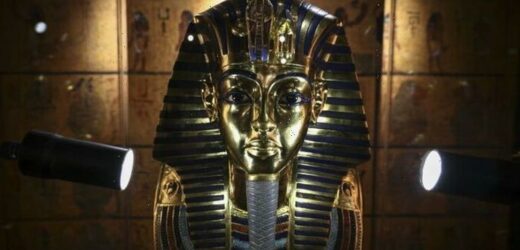Ancient Egyptian's belief in multiple gods explained
We use your sign-up to provide content in ways you’ve consented to and to improve our understanding of you. This may include adverts from us and 3rd parties based on our understanding. You can unsubscribe at any time. More info
Experts were stunned when they discovered that the spectacular artefact was made from the iron which comes from meteors. The discovery was made by a team of Japanese and Egyptian researchers working with the Egyptian Museum in Cairo. They found that the raw meteorite of the dagger blade was likely to be octahedrite, which is the most common class of iron meteorites.
They also argued that the object probably arrived as a gift from Anatolia (modern-day Turkey).
But in a study published in the February 11 edition of the journal Meteoritics & Planetary Science, experts argued that an adhesive placed on the dagger’s gold hilt was made of lime plaster.
This material was used in Anatolia at the time Tutankhamun reigned, while not widely used in Egypt.
And that was not the only piece of evidence that pointed to that Anatolia.
Historical records discovered at the site of Amarna, in Egypt, revealed that Tushratta, the king of Mitanni in Anatolia, gave at least one iron dagger to Amenhotep III as a gift.


Amenhotep III reigned Ancient Egypt from about 1390 BC to 1352 BC and was thought to be Tutankhamun’s grandfather.
The experts also discovered that the dagger was manufactured using a low-temperature heat forging process at less than 950C.
But other experts are at loggerheads with fellow researchers, disputing the claim that the dagger was not an Anatolian export.
The authors of “Iron from Tutankhamun’s Tomb” argue the mystery is still completely unsolved.
Instead of deciding on a definite conclusion, those researchers have argued that it is currently “impossible” to decipher where the dagger came from, or whom it was made by.

But they have been able to narrow some of the evidence down.
They have noted that the “rock crystal” made from the blade’s pommel resembled some artefacts that were commonly widely used in the Aegean region.
But they described the pommel’s shape as “typically Egyptian”.
The archaeologists argue that this indicates that it could have been constructed either in Egypt or as a product to be exported to the Egyptian market.”
The researchers said that this means “no clear overall picture on the origin of the dagger’s handle and blade” can be made.
DON’T MISS
Egypt breakthrough as archaeologist find ancient cache of supplies [REVEAL]
Archaeologists stunned by ‘fascinating’ Iron Age ‘time capsule’ [[INSIGHT]
Poland ‘under attack’ – fears for Ukraine’s neighbour over Ukraine war [REPORT]


Tutankhamun ruled over the18th Dynasty of Ancient Egypt, between 1361 and 1352 BCE.
This was during the Late Bronze Age, around 150 years before iron-processing technology was commonly used, making the dagger mystery all the more baffling.
Tomoko Arai, from the Planetary Exploration Research Center at the Chiba Institute of Technology, said: “The origin of Tutankhamen’s iron dagger is crucial as it directly affects the widely accepted history of human civilisation from the Bronze Age to the Iron Age.
“The time of King Tut [as he is commonly known in the English-speaking world], around 1300 BCE, corresponds to the Late Bronze Age, and the Iron Age is believed to have begun around 1200 BCE.”
Source: Read Full Article


